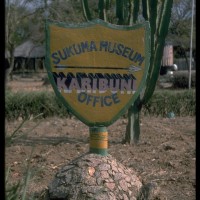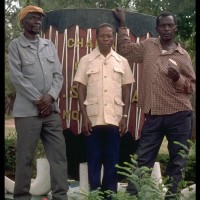
Sukuma Museum Mission Statement
The Sukuma Museum is a community based organization that promotes and celebrates the traditional and contemporary arts of the Sukuma culture. The Museum provides an interactive and educational environment where Sukuma elders teach younger generations traditional history and arts, and younger generations are encouraged to develop and expand creative voices and new Sukuma artistic trends. The Museum also welcomes visitors to workshops that provide training for those interested in learning the traditional arts of the Sukuma. The Museum is the only institution devoted to Sukuma culture and is the sole benefactor of objects from the ancient Sukuma chiefdoms and Dance societies.
Profile of the Sukuma Museum
The Bujora Cultural Center and Sukuma Museum in Kisesa, Tanzania, are historical institutions founded for the education and support of Sukuma culture. The arts of the Sukuma culture are among the richest in East Africa. As the Sukuma people are the largest cultural group in Tanzania, the Sukuma culture is dispersed throughout the country. The heart of Usukuma is in the Lake Zone of Mwanza, Shinyanga and the Mara regions where the legacy of a rich art tradition is now maintained.

The Sukuma Museum has a target audience of 1.5 million people. The Museum is visited by approximately 2,000 paying visitors annually, numerous schools from the Mwanza region and many more local residents participate daily at the Center and utilize the Museum grounds as well as many foreign visitors. The Bujora Cultural Center was founded in 1954. Today it is administered by the Bujora Board of Advisors Committee and the Bujora Coordination Committee. A General manager, Chairman, Museum Director and African Clinic Coordinator serve as the main administration, while a support staff including a museum guide, accountant, and three environmental services personnel help to oversee the Museum. In addition, five teachers instruct the students of the Handicraft School in traditional Sukuma arts.

The Sukuma Museum represents the only institution devoted solely to the history of Sukuma art and culture. Designed in 1968 with the aid of the Bujora Sukuma Research Committee, the Museum still maintains its mission to promote and celebrate Sukuma culture within the community. Mapped out on the Museum grounds are traditional architectural structures from Sukuma history, such as the dwellings of the blacksmith, traditional doctor and elder Sukuma individuals, as well as a traditional compound, a Royal Pavilion to house the chiefly regalia and a Dance Pavilion for the history of the Bagika and Bagalu dance societies. The important objects and artifacts of the collection have been donated by Sukuma elders and royal families for the preservation of Sukuma culture. Objects include royal drums and regalia, costumes and accessories of the dance societies, objects and healing devices unique to traditional Sukuma doctors, and traditional furniture, weapons and utilitarian objects.
The Sukuma Museum and Cultural Center provides an artistic, spiritual, intellectual and community focal point for Sukuma culture, which both celebrates and promotes the creativity of traditional and contemporary Sukuma art, architecture, and dance. As the first cultural institution to represent the Sukuma people, the Museum was the seed that evolved into the Bujora Cultural Center. Today the Cultural Center serves as the umbrella organization for the Sukuma Museum, the Sukuma Archives, the Sukuma Research Committee, the African Clinic, the Bujora Church, the Bana Sesilia Dance Troupe, the Handicraft School and the Course Center.
The Sukuma Museum is not a repository that attempts to simply salvage the past and look upon it nostalgically, but rather is a vibrant, “living” institution based on the promotion of Sukuma culture and community outreach. The annual Bulabo Dance Festival, sponsored by the Museum, provides a meeting ground where traditional culture is celebrated and contemporary innovations are performed through dance competitions and especially between the famous Bagalu and Bagika dance societies. Kisukuma is the first language of the dance societies, the Sukuma Research Committee and the Museum, where a conscious effort has been made to provide labels and information in Kisukuma, Kiswahili, and English.
As the Center enters its forty-first year, the time is right for a revitalization of the Museum’s infrastructure which is fast becoming too outdated to properly care for the art objects. Many of these works were donated from the Sukuma community and most importantly from the chiefs, traditional doctors and dance societies. In 1995, a Dutch scholar, Franz Wijsen, was sponsored to index the Sukuma Archives and train a local librarian, two American art historians, Mark Bessire and Aimee Bessire, have just completed registering and photographing the art collection for the Museum. Using the information from the registration and conservation reports, we have organized a viable strategic plan for the conservation of the art objects and the redesigning of the exhibition halls. We need to safeguard the objects from the elements and to increase the educational impact of the collection. The Mission Statement we adopted in 1995 has helped guide us from short term problem solving to a long term planning process and will help us see beyond the day to day process to reach our goals.
Goals of the Museum
Over the past five years, the Museum’s goal has been to reach a level of financial self-sufficiency and today the Museum has achieved its aim. Although the Museum is able to meet everyday expenses, there is not an endowment or a maintenance fund to keep pace with the depreciation of the museum buildings, exhibitions, and conservation of the Sukuma art/artifacts. The largest threat to the Sukuma Museum is the deterioration of both Sukuma historical architectural structures and invaluable historical objects due to the lack of appropriate materials and exhibition spaces. We are now reaching out to a wider community to help us support the maintenance of our unique and valuable collection of Sukuma culture.
The Sukuma Museum’s Long Term Plan
The long term plan of the Museum is to rehabilitate exhibition spaces and restore architectural structures, to photograph, register and document the Museum’s Permanent Collection, to safeguard and conserve endangered artifacts, and to index the Sukuma Archives. Of this four part strategy the Museum has nearly completed the indexing of the Sukuma Archives and the registering and photographing of the Permanent Collection. The project will facilitate the Museum’s ability to reach a greater audience with a more comprehensive educational role. The indexing and registration has already increased scholarly access to the Permanent Collection and Archives. The Museum recognizes that without the proper care and documentation of its Permanent Collection and traditional architectural structures, it will not be able to continue to accept cultural donations from the Sukuma community or raise outside financial support.
Funding Sources of the Sukuma Museum
The Center is a tax-exempt institution which earns income through Museum admissions, shop sales, canteen revenues, workshop fees, course center revenues (camping and accommodations) and Handicraft School fees. In the past the Center has received funding from Mwalimu Julius Nyerere, the Danish Volunteer Service, Ulandsforden Developing Countries in Denmark, the Peace Development Fund of Canada and DGI of Denmark. Over the past five years, the Museum’s goal has been to reach a level of financial self-sufficiency and today the Museum has achieved its aim. Although the Museum is able to meet everyday expenses, there is not an endowment or a maintenance fund to keep pace with the depreciation of the museum buildings, exhibitions, and conservation of the Sukuma art/artifacts. We are reaching out to a wider community to help us support the maintenance of our unique and valuable collection of Sukuma culture.
Text and photo are courtesy of Mark & Aimee Bessire, USA.